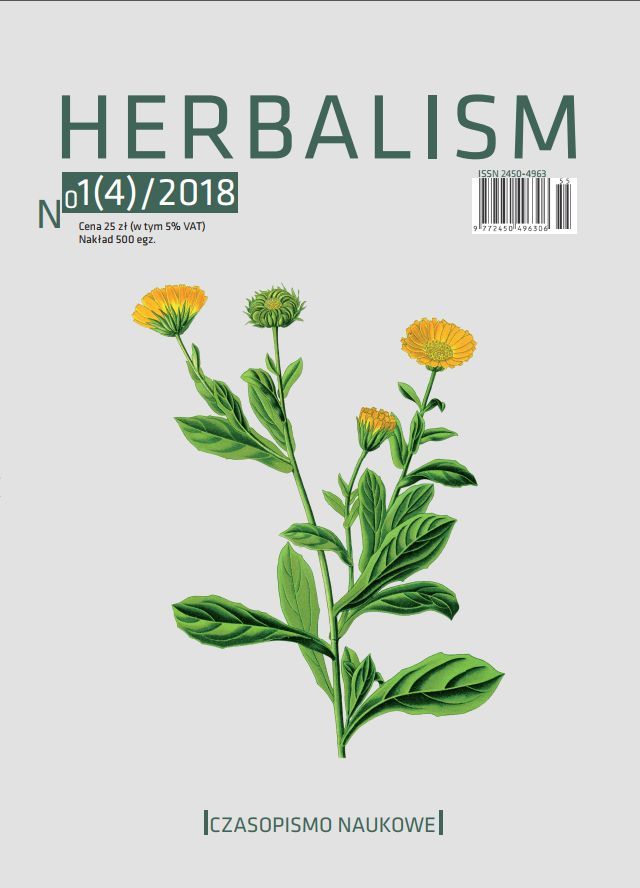Analiza zapachu wybranych odmian mięty (Mentha sp.)
DOI:
https://doi.org/10.12775/HERB.2018.005Parole chiave
mięta, Mentha, odmiany smakowo-zapachowe, profil sensoryczny, deskryptorAbstract
Mięty (Mentha sp.) są roślinami łatwo krzyżującymi się, dzięki czemu w prosty sposób można otrzymać hybrydy oraz nowe odmiany o zmodyfikowanych walorach smakowo-zapachowych wykazujących zapach oraz smak przypominający popularne owoce lub produkty spożywcze. W pracy przedstawiono wyniki oceny sensorycznej suszonych liści mięty. Analizie poddano 8 smakowo-zapachowych odmian mięt: pieprzową (M. × piperita L. 'Multimentha'), grejpfrutową (M. × piperita L. 'Grapefruit'), jabłkową (M. rotundifolia (L.) Huds.), pomarańczową (M. × piperita L. 'Granada'), czekoladową (M. × piperita L. 'Chocolate'), truskawkową (M. × piperita L. 'Almira'), jagodowo-śmietankową (Mentha × 'Berries & Cream'), ananasową (M. suaveolens Ehrh.). Wśród badanych mięt największą intensywnością zapachu cechuje się mięta pieprzowa, natomiast najmniejszą – mięta jabłkowa. Profile sensoryczne badanych odmian mięty okazały się bardzo zróżnicowane: w przypadku mięty truskawkowej, jagodowo-śmietankowej oraz ananasowej jednym z najbardziej wyczuwalnych zapachów był deskryptor ziołowy. Mięta pieprzowa, jabłkowa i cze-koladowa charakteryzowały się najintensywniejszym deskryptorem mentolowym. W przypadku mięty pomarańczowej i grejpfrutowej najbardziej wyczuwalny był zapach cytrusowy. W ocenie hedonistycznej najwięcej pozytywnych ocen uzyskała mięta pieprzowa, najwięcej negatywnych natomiast mięta ananasowa. Różnorodność właściwości aromatycznych i smakowych badanych odmian mięt wskazuje na możliwość różnorodnego ich wykorzystania.
Riferimenti bibliografici
Iwaszczuk N., Szyba M., Przyszłość branży spożywczej – między innowacją a bezpie-czeństwem żywności, [w:] Zarządzanie i bezpieczeństwo w łańcuchu żywnościowym, red. Walaszczuk A. Jałmużna I., Lewandowski J., Monografie Politechniki Łódzkiej 2016, s. 81–91.
Czerpak R., Jabłońska-Trypuć A., Roślinne surowce kosmetyczne, MedPharm Polska 2008.
Kiełtyka-Dadasiewicz A., Jabłońska-Trypuć A., Taraseviciene Z., Kubat-Sikorska A., Charakterystyka i właściwości użytkowe surowców miętowych, Towaroznawcze Pro-blemy Jakości, 2016, 1(46), s. 93–105.
Korczak J., Przyprawy i ich rola w kształtowaniu jakości sensorycznej produktów spożywczych i potraw, [w:] Zmysły a jakość żywności i żywienia, (red.) J. Gawęcki, N. Baryłko-Pikielna, Wydawnictwo Akademii Rolniczej w Poznaniu 2007, s. 111–128.
Góra J., Lis A., Najcenniejsze olejki eteryczne, Wydawnictwo Uniwersytetu Mikołaja Kopernika, Toruń 2004, s. 204–214.
Westerfield J.E., Hillary’s Sweet Lemon’s Mint. United States Patent USOOPPO9197P, 1995.
Ludwiczuk A., Kiełtyka-Dadasiewicz A., Sawicki R., Golus J., Ginalska G., Essential oils of some Mentha species and cultivars, their chemistry and bacteriostatic activity, Natural Product Communications, 2016, 11(7), s. 1015–1018.
Kiełtyka-Dadasiewicz A., Kubat-Sikorska A., Walory smakowo-zapachowe niemento-lowych odmian mięt (Mentha Sp.), Herbalism, 2016, 1 (2), s. 107–116.
PN-ISO 11035, Analiza sensoryczna – Identyfikacja i wybór deskryptorów do ustalania profilu sensorycznego z użyciem metod wielowymiarowych, s. 2–15.
Łysoniewska E., Kalisz S., Mitek M., Jakość sensoryczna nektarów i napojów z czarnej porzeczki wzbogaconych ekstraktami z jeżówki purpurowej oraz zielonej herbaty, Żywność. Nauka. Technologia. Jakość, 2011, 6 (79), s. 167–177.
Downloads
The publisher's shop:
Pubblicato
Come citare
Fascicolo
Sezione
Licenza

Questo lavoro è fornito con la licenza Creative Commons Attribuzione - Non opere derivate 4.0 Internazionale.
Stats
Number of views and downloads: 1492
Number of citations: 0



